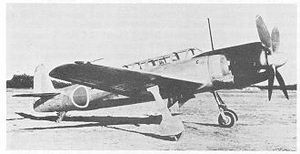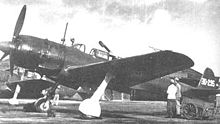- Nakajima C6N
-
C6N Nakajima C6N Role Carrier based reconnaissance aircraft National origin Japan Manufacturer Nakajima Aircraft Company First flight 15 May 1943 Introduction 1944 Retired 1945 Primary user Imperial Japanese Navy Air Service Number built 463 The Nakajima C6N Saiun (彩雲, "Coloured Cloud") was a carrier-based reconnaissance aircraft used by the Imperial Japanese Navy Air Service in World War II. Advanced for its time, it was the fastest carrier-based aircraft put into service by Japan during the war. The Allied reporting name was Myrt.
Contents
Development and design
The C6N originated from a 1942 Imperial Japanese Navy specification for a carrier-based reconnaissance plane with a top speed of 350 knots (650 km/h) at 6,000 m and range of 2,500 Nautical miles (4,960 km).[1] Nakajima's initial proposal, designated N-50, was for a craft with two 1,000 hp engines housed in tandem in the fuselage, driving two propellers mounted on the wings. With the development of the 2,000 hp class Nakajima Homare engine though, this configuration was abandoned and Nakajima decided on a more conventional single-engine layout. However, the Homare's output turned out to be less than initially expected, so the design had to be optimized in other areas. The resulting aircraft was designed around a long and extremely narrow cylindrical fuselage, just large enough in diameter to accommodate the engine. The crew of three sat in tandem under a single canopy, while equipment was similarly arranged in a line along the fuselage. The C6N's low mounted laminar flow wing housed fuel tanks and was fitted with both Fowler and slit flaps and leading edge slats to lower the aircraft's landing speed to ease use aboard aircraft carriers.[2] Like Nakajima's earlier B6N "Tenzan" torpedo bomber, the rudder was angled slightly forward to enable tighter packing on aircraft carriers.
The first flight was on 15 May 1943, with the prototype demonstrating a speed of 639 km/h (345 kt, 397 mph).[3] Performance of the Homare engine was disappointing, especially power at altitude,[3] and a series of 18 further prototypes and pre-production aircraft were built, before the Sauin was finally ordered into production in February 1944.[3][4]
Operational history
Although designed for carrier use, by the time it entered service in September 1944, there were few carriers left for it to operate from, so most were used from land bases. Its speed was exemplified by a famous telegraph sent after a successful mission: "No Grummans can catch us." ("我に追いつくグラマンなし"). The top speed of the Grumman F6F Hellcat was indeed of the same level, so overtaking a Sauin was out of the question.[3][5]
A total of 463 aircraft were produced.[6] A single prototype of a turbocharged development mounting a 4-blade propeller was built, this was called the C6N2 Saiun-kai. A night-fighter version C6N1-S with oblique-firing (Schräge Musik configuration) single 30 mm (or dual 20 mm) cannon and a torpedo carrying C6N1-B were also developed. The C6N1-B developed by Nakajima was not needed after Japan's aircraft carriers were destroyed. As Allied bombers came within reach of the Japanese home islands, there became a need for a first class night fighter. This led Nakajima to develop the C6N1-S by removing the observer and replacing him with two 20mm cannons. The C6N1-S's effectiveness was hampered by the lack of air-to-air radar, although it was fast enough to enjoy almost complete immunity from interception by Allied fighters.
Despite its speed and performance, on 15 August 1945, a C6N1 was the last aircraft to be shot down in World War II. Just five minutes later, the war was over and all Japanese aircraft were grounded.[6]
Variants
- C6N-1 : Two-seat reconnaissance aircraft for the Imperial Japanese Navy.
- C6N-1B : Proposed torpedo-bomber version. Unbuilt.
- C6N-1S : Small number of C6N-1s converted into night fighters.
- C6N-2 : One prototype fitted with a 1,980-hp (1476-kW) Nakajima NK9K-L 24 Homare turbocharged engine.
- C6N-3 : Projected night-fighter version of the C6N-2. Project only.
Specifications (C6N1)
Data from Japanese Aircraft of the Pacific War[6]
General characteristics
- Crew: 3
- Length: 11.00 m (36 ft 1 in)
- Wingspan: 12.50 m (41 ft 0⅛ in)
- Height: 3.96 m (13 ft 0 in)
- Wing area: 25.5 m² (274 ft²)
- Empty weight: 2,968 kg (6,543 lb)
- Loaded weight: 4,500 kg (9,921 lb)
- Max takeoff weight: 5,260 kg (11,596 lb)
- Powerplant: 1 × Nakajima NK9B Homare 11 18 cylinder two-row air-cooled radial engine, 1,485 kW (1,990 hp)
Performance
- Maximum speed: 610 km/h (329 knots, 379 mph) at 6,100 m (20,000 ft)
- Cruise speed: 390 km/h (210 knots, 242 mph)
- Range: 5,300 km (2,886 NM, 3,300 mi) (with auxiliary fuel[7])
- Service ceiling: 10,470 m (35,240 ft)
- Wing loading: 176 kg/m² (36.2 lb/ft²)
- Power/mass: 0.33 kW/kg (0.20 hp/lb)
- Climb to 6,000 m (19,700 ft): 8 min 9 sec
Armament
- Guns: 1× flexibly mounted rearward-firing 7.92 mm Type 1 machine gun
See also
- Related lists
References
- Notes
- Bibliography
- Francillon, Ph.D., René J. Japanese Aircraft of the Pacific War. London: Putnam & Company Ltd., 1970. ISBN 0-370-00033-1 (2nd edition 1979, ISBN 0-370-30251-6).
- Francillon, Ph.D., René J. Japanese Carrier Air Groups, 1941-45. London; Osprey Publishing Ltd., 1979. ISBN 0-85045-295-3.
- Mondey, David. The Concise Guide to Axis Aircraft of World War II. London: Chancellor Press, 1996. ISBN 1-85152-966-7.
External links
- Joao Paulo Julião Matsuura (1997). "Nakajima C6N Saiun (Painted Cloud)". WWII Imperial Japanese Naval Aviation Page. http://www.combinedfleet.com/ijna/ijnaf.htm. http://www.combinedfleet.com/ijna/c6n.htm. Retrieved 9 September 2010.
Aircraft produced by Nakajima Aircraft Company Imperial Japanese Navy types Imperial Japanese Army types World War II Allied reporting names Japanese Navy Reconnaissance Aircraft designation series World War II Allied reporting names for Japanese aircraft Aircraft in Japanese service Abdul • Alf • Ann • Babs • Baka • Belle • Betty • Bob • Buzzard • Cedar • Cherry • Clara • Claude • Cypress • Dave • Dick • Dinah • Dot • Edna • Emily • Eva • Eve • Frances • Frank • Gander • George • Glen • Goose • Grace • Gwen • Hamp • Hank • Hap • Helen • Hickory • Ida (Tachikawa Ki-36) • Ida (Tachikawa Ki-55) • Irving • Jack • Jake • Jane • Jean • Jerry • Jill • Jim • Judy • Kate • Kate 61 • Laura • Lily • Liz • Lorna • Loise • Louise • Luke • Mabel • Mary • Mavis • Myrt • Nate • Nell • Nick • Norm • Oak • Oscar • Pat • Patsy • Paul • Peggy • Perry • Pete • Pine • Rex • Rita • Rob • Rufe • Ruth • Sally • Sally III • Sam • Sandy • Slim • Sonia • Spruce • Stella • Steve • Susie • Tabby • Tess • Thalia • Thelma • Theresa • Thora • Tina • Tillie • Toby • Tojo • Tony • Topsy • Val • Willow • Zeke • Zeke 32
Nonexistent aircraft thought to be in Japanese service Adam • Ben • Doris • Gus • Harry • Ione • Joe • Joyce • Julia • June • Norma • Omar • Ray
Foreign aircraft erroneously thought to be in Japanese service Lists relating to aviation General Aircraft (manufacturers) · Aircraft engines (manufacturers) · Airlines (defunct) · Airports · Civil authorities · Museums · Registration prefixes · Rotorcraft (manufacturers) · TimelineMilitary Accidents/incidents Records Categories:- Propeller aircraft
- Single-engine aircraft
- Low wing aircraft
- Carrier-based aircraft
- Japanese military reconnaissance aircraft 1940–1949
Wikimedia Foundation. 2010.


